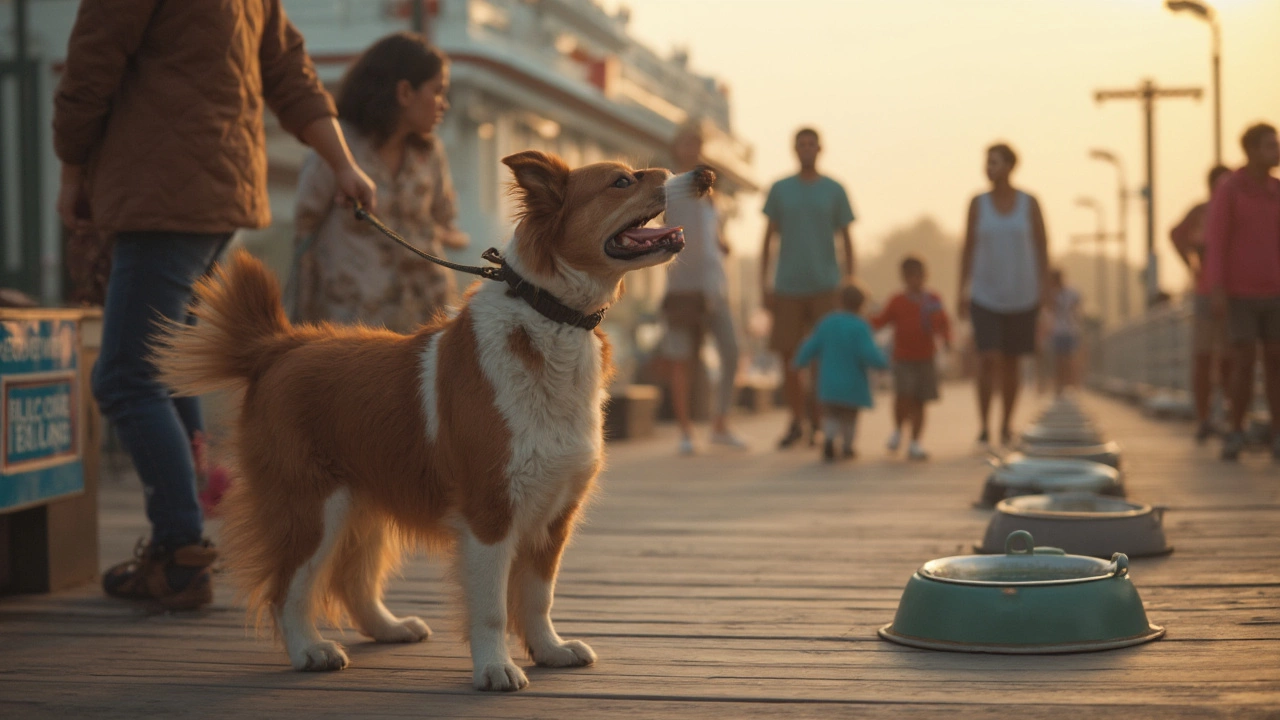
Ask any dog parent who’s explored Maryland, and you’ll get wildly different stories. Some swear it’s a paradise for pups, packed with dog beaches and pet-friendly patios. Others grumble about confusing leash laws or spots where ‘No Dogs Allowed’ signs ruin the fun. So, is Maryland a dog-friendly state or just pretending? Either way, dogs aren’t shy about letting you know how they feel – just watch their tails. Here’s what’s really going on for four-legged adventurers in the Old Line State.
Maryland’s Dog Laws: What Owners Need to Know
Before hitting the trails or grabbing a table at a crab shack with your furry buddy, you’ve got to understand Maryland’s patchwork of dog laws. Weirdly enough, these rules can shift not just from city to city, but sometimes block to block. What you can do in Baltimore might slide in Annapolis, but could land you a hefty fine in neighboring Howard County. So, yeah, it pays to be informed.
First up, leash laws. Maryland doesn’t have a state-wide leash rule, but every county and most cities do. For instance, Baltimore requires dogs to be leashed when off your property, no exceptions. Montgomery County, just outside DC, enforces a strict leash ordinance, too. But certain state parks or rural trails let leashed dogs run loose at designated times. Always look for posted signs – sometimes regulations change due to wildlife, seasonal events, or even bird migrations.
Vaccinations are a must, especially rabies. Maryland law requires all dogs four months and older to be vaccinated. Public dog parks, kennels, and daycares almost always check for up-to-date records. Even short-term rentals or pet-friendly hotels might ask for proof, so keep those papers handy or snap a pic of the vet record on your phone.
Some breeds, unfortunately, face extra hurdles. After a notorious court case in 2012, Maryland temporarily labeled pit bulls as “inherently dangerous.” The law’s changed, but pockets of insurance and rental restrictions still linger. Always double-check if your breed faces any specific bans, especially when moving or visiting unfamiliar counties. On a positive note, Maryland’s ‘Dog Bite Law’ focuses more on ownership responsibility than breed generalizations, so evidence of good behavior can help if disputes come up.
Dog tags aren’t just a cute accessory. In most places, local registration is required every year or two. If animal control picks up your dog, a tag almost guarantees a swift reunion. License fees usually run between $10 and $25, and having your dog microchipped can knock a chunk off your yearly dues. Plus, the tag fee often helps local shelters, which is an easy way to double down on good karma.
Lastly, Maryland leans hard into “pet owner liability.” If your dog bites someone or destroys property, you can be held responsible unless you prove you took reasonable precautions. That means keeping your dog leash-trained, socialized, and under control, especially in crowded places. Certain insurance policies even have pet liability riders – it’s not a bad idea if you have a big or excitable pooch.
Here’s a quick comparison of a few key dog regulations in major Maryland counties:
| County/City | Leash Law | Breed Restrictions | Dog Park Access | Pet License Required |
|---|---|---|---|---|
| Baltimore | Leash required in public | None | Registered dogs only | Yes |
| Montgomery | Leash required | None | Permit needed for off-lead | Yes |
| Anne Arundel | Leash required | Some restrictions for rentals | Exclusive dog parks | Yes |
| Howard | Leash required | Case-by-case | Wilde Lake 3-acre park | Yes |
| Frederick | Leash required | None | No fee for parks | Yes |
Dog-Friendly Places and Activities: The Hidden Gems
If your dog could make the vacation plans, they’d want lakes, fire hydrant stops, peanut butter treats, wide trails, and maybe a few seagulls. Lucky for them, Maryland is more than just beaches and blue crab boils – though, let’s face it, you’ll want some of those too. The real magic is in the places you barely hear about but that canine locals swear by.
Start with parks. Wag your way to Quiet Waters Park (Annapolis), where two sprawling dog beaches let pups go wild off-leash, splash in the shallows, or just roll in the sand. On weekends, you’ll see a parade of labs and corgis chasing floating sticks while owners sip iced coffee from the waterfront café. Over in Baltimore, Patterson Park cracks open a fenced, off-leash area, and at sunrise, there’s usually a game of fetch that only stops when the humans need to clock in at work.
Mountain-loving mutts rejoice: Catoctin Mountain Park and Gambrill State Park in Frederick County allow leashed pets on nearly every trail. These aren’t boring gravel paths either – think boulder scrambles and shaded climbs, with waterfall views and thick, pine-scented air. Summer weekends pull in trail runners and hiking groups, but weekday mornings? Your dog gets the forest all to themselves. Don’t miss the Black Ankle Vineyards trail loop, where friendly staff leave water bowls out for visiting dogs, so you don’t have to lug extra supplies.
If you’re chasing waves, Maryland’s Atlantic shore is surprisingly open to dogs – but with quirks. Ocean City beaches ban canines from May 1 to late September (sad trombone), but let them roam free in the off-season. Drive 30 minutes south to Assateague National Seashore and you’ll spot dogs (on leash) prancing on empty dunes, dodging wild ponies, and soaking up salt air. Bring poop bags, as rangers are strict about cleanliness in these protected habitats.
For rainy days or apartment dwellers, dog-friendly breweries and coffee shops have taken off. Union Craft Brewing in Baltimore hosts monthly dog socials with giveaways, while Silver Branch in Silver Spring encourages pups to sprawl under picnic tables on Saturdays. Don’t overlook retailers like The Big Bad Woof in Takoma Park, offering a water bar featuring filtered water, goat’s milk, and chicken-based ‘dog broth’ for hot months.
One unexpected gem is the Maryland Renaissance Festival. It’s become a costume paradise for both owners and dogs – picture golden retrievers in chainmail and Boston terriers dressed as medieval jesters. Tickets for dogs sell out (yes, they need one), so plan ahead if you want to mingle with fellow history-loving hounds.
Here’s a shortlist of top places your four-legged explorer shouldn’t miss:
- Quiet Waters Park Dog Beach (Annapolis) – Sun, sand, and launched tennis balls.
- Wilde Lake Dog Park (Columbia) – Three sprawling fenced acres, shade, and plenty of dog pals.
- Catoctin Mountain Park – Leashed, but wild, with trails for every size and energy level.
- Assateague National Seashore – Wild ponies AND sand for digging.
- Union Craft Brewing (Baltimore) – Doggie socials and local brews for humans.
- The Maryland Renaissance Festival – Dress-up day for both species!
- Lake Elkhorn Loop (Columbia) – Paved, stroller-friendly, and plenty of water access.
- Retriever Row (Locally run Baltimore pet shops) – Many shops hand out treats to furry visitors.

Dining Out and Overnight Stays: The Real Scoop for Dogs
So, you want to grab dinner or crash overnight and you’re bringing your dog. Time to decode Maryland’s hospitality scene for pet lovers. On the food front, Maryland is catching up with the rest of the East Coast, and it’s rare to see a busy patio without at least a couple of snoozing pups under the tables.
Many local restaurants advertise themselves as ‘dog-friendly,’ but the details are crucial. Some spots only allow dogs on the outdoor patio, while others reserve a handful of tables (often the wobbly ones by the sidewalk grate) for guests with pets. A few go above and beyond: Waterfront Kitchen (Baltimore) has a dedicated ‘Yappy Hour’ menu that includes dog-safe peanut-butter treats and frozen yogurt bowls. In Frederick, Brewer’s Alley sets out complimentary water bowls; the staff will sometimes sneak your dog a fresh-baked dog biscuit if you ask.
Don’t just assume you can waltz in; call ahead and double-check if there are size restrictions. Some places (especially downtown Annapolis during peak tourist season) only allow smaller breeds when crowds swell. You might need to bring your own dog mat or a portable water bowl, since not every place stocks them. And, pro tip—restaurants will occasionally host special “Dog Days” with play areas and treat samples, so keep an eye on social media for those events.
Hotels have definitely gotten the memo that dogs travel now. Chains like Kimpton, Westin, and Marriott usually allow pets in specific Maryland locations. Expect pet fees between $25 and $75 a night, although sometimes independent B&Bs will let friendly dogs stay free if you vouch for them. Don’t gloss over the hotel policy: some measure dogs by weight, others by breed, and almost always they cap it at two animals per room. Always mention you have a dog when booking, or risk a grumpy concierge and a rough check-in.
Vacation rentals are where you can get creative. On sites like Airbnb or VRBO, look for the ‘pets allowed’ filter, but read reviews—you’ll spot notes about fenced yards, nearby dog parks, or even owner-provided dog beds and bowls. A few Maryland hosts leave special welcome baskets with homemade dog treats, waste bags, and towels. That local touch makes the difference when you’re traveling with muddy paws and sandy fur.
Traveling with a service animal is easier, of course, thanks to the ADA. But for emotional support animals, rules have tightened, especially with recent airline and accommodation regulation updates. Always have paperwork at the ready—especially when staying in downtown areas or luxury resorts where rules can be stricter.
Quick recap for travel planning:
- Call restaurants and hotels before booking. Clarify breed, size, and number of pet restrictions.
- Check for extra cleaning/facility fees at hotels. Some cap the number or restrict access to certain floors.
- Pack portable food and water bowls, a favorite bed, and extra towels for unexpected mud or rain.
- Look for dog-friendly vacation rentals with fenced yards or proximity to dog parks—they get rave reviews from pet owners.
- Bring medical/vaccine records. Some properties request them, especially after Covid-19 concerns.
- For beach stays, carefully review off-season vs. peak season dog regulations.
Challenges and Smart Tips for Dog Owners in Maryland
Even the friendliest state has a few curveballs, and Maryland’s no different if you’ve got a dog. Dog parks are popular and usually safe, but summer crowds mean more risk of scuffles, so bring a long leash until you know the pack. The Chesapeake Bay region, while beautiful, attracts ticks, fleas, and mosquitoes eager to hitch a ride on your dog. Locals swear by monthly preventatives and routine vet checks after every big outdoor adventure.
Maryland’s weather can throw you and your pup for a loop. Summers bring muggy heat and sudden thunderstorms; winters can slam you with icy rain or several feet of snow. Keep a weather app close and be ready to switch plans from a hike to an indoor coffee shop social. Always check your dog’s feet for salt or ice melt after city strolls—the chemicals hurt paw pads. If your dog is new to loud noises, Baltimore’s famous Fourth of July fireworks show will test their nerves, so have a quiet space or white noise ready.
Housing can get tricky, especially for renters. Some complexes have unclear “pet policy” language or breed/weight limits written in the small print, so don’t sign until you get answers in writing. Homeowners’ associations (HOAs) in places like Columbia and Bowie sometimes set their own rules about fences, dog runs, or how much noise is “too much.” A little research before moving in can spare you a big headache later.
Maryland is big on community events and fundraisers involving dogs, but they fill up fast. Doggy 5Ks, pet parades, and costume contests (like the Baltimore Halloween Pet Parade) draw huge crowds, so register as soon as you can. Not only are they a blast, but some events support local shelters, so your entry fee helps pups still waiting for their forever homes.
If your pup has special needs—like limited mobility, reactivity, or anxiety—Maryland’s resources are actually pretty solid. The Baltimore Humane Society holds monthly ‘quiet hours’ in their parks for sensitive dogs, and virtual vet consultations are easy to set up. For emergencies, most counties have at least one 24-hour animal hospital; research their locations and keep the numbers saved in your phone before you need them.
Smart tips for a smoother dog life in Maryland:
- Stock up on tick/flea preventatives, especially for spring/summer hikes.
- Bring water and shade devices on long walks—heat exhaustion creeps up fast during humid spells.
- Introduce your dog to Maryland wildlife (deer, squirrels, foxes) slowly if they’ve never lived out East before.
- Rely on apps like BringFido or DogFriendly for last-minute pet-friendly rest stops and restaurants.
- Check out your nearest local Facebook group for real-time answers about dog park conditions and events.
- If renting, get every pet policy detail in email so you’re protected if managers change.
- Visit county shelters and support their fundraisers—even small donations keep their doors open for lost pups.
Now, is Maryland a dog friendly state? Most pups – and their owners – would probably wag their tails and say yes. There are hoops to jump through (especially for renters or those with misunderstood breeds), yet at every turn you’ll find new places eager to welcome wagging tails. Whether you live here or just passing through, Maryland’s mix of wild spaces, dog-focused events, and a growing network of pet-friendly businesses makes it one of the easier spots to live the ‘bring your dog everywhere’ life. Just pay attention to the rules, look for the hidden gems, and remember: it’s not a real Maryland adventure until your dog’s got sand in their fur and a treat from a total stranger in their mouth.





